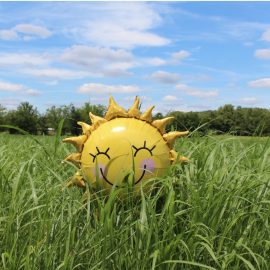

This article is an excerpt from the Shortform book guide to "The Oxygen Advantage" by Patrick McKeown. Shortform has the world's best summaries and analyses of books you should be reading.
Like this article? Sign up for a free trial here.
What is the book The Oxygen Advantage about? What are the main takeaways of the book?
In The Oxygen Advantage, breathing coach Patrick McKeown explains why excessive breathing results in less oxygen getting to your body. To learn how to breathe less, he teaches specific exercises that you can practice at any time.
Read below for a brief The Oxygen Advantage book overview.
The Oxygen Advantage by Patrick McKeown
Imagine there was a miracle cure that could help you feel less stressed, lose weight, sleep better, run farther without losing your breath, and live longer. According to author Patrick McKeown’s, not only does this cure exist, but it’s also free to anyone with a set of lungs—it’s practicing proper breathing. According to McKeown, modern living conditions cause the average person to breathe too much, but by training yourself to breathe less, you can greatly improve your physical fitness and overall health.
McKeown suffered from severe asthma until the age of 26. But after discovering the work of respiration expert Konstantin Buteyko, McKeown developed breathing exercises that eliminated his asthma symptoms and radically improved his quality of life. This experience inspired him to continue studying breathing under Buteyko. Eventually, McKeown became a personal breathing coach, helping Olympic athletes improve their performance and helping people of all kinds bolster their health. He wrote The Oxygen Advantage book, published in 2016, to further raise awareness of the benefits of proper breathing.
The Problem: You Breathe Too Much
McKeown asserts that breathing too much is a widespread habit degrading the health of almost everyone in modern society. Specifically, the average person inhales and exhales more frequently than they should and breathes habitually through the mouth, a larger airway than the nose. But why is taking in more air than you need so bad for you?
We’ll begin this section by breaking down what happens in your body when you breathe and how this changes when you breathe too much. Then, we’ll detail the adverse health effects of heavy breathing. Finally, we’ll use this information to explain why modern society causes so many people to breathe too much.
How Breathing Too Much Hurts You
McKeown explains that breathing serves two main functions: taking in oxygen and expelling carbon dioxide. First, you inhale oxygen because the muscles and organs in your body need it to function. When you inhale, tiny air sacs inside your lungs called alveoli absorb oxygen and pass it into the bloodstream. Your circulatory system ensures that this oxygen travels to your muscles and organs.
Second, you exhale carbon dioxide because your digestive system produces more of it than your body needs as it breaks down food into energy. Additionally, your body generates a lot of carbon dioxide whenever you physically exert yourself, as a byproduct of intense muscle activity.
Breathing More Blocks the Flow of Oxygen
Generally, the more oxygen your body sends to your various muscles and organs, the better they can do their jobs, asserts McKeown. However, breathing too much causes your muscles and organs to absorb less of the oxygen in your bloodstream, preventing them from working optimally.
When you breathe too much, you exhale large amounts of carbon dioxide, removing it from your blood. This is unhealthy because blood needs carbon dioxide in it to pass oxygen on to muscles and organs—a phenomenon called the Bohr effect. The less carbon dioxide there is in your blood, the less your body can access its blood oxygen.
Many assume that breathing excessively is good for you because it increases the amount of oxygen you inhale into your body. However, McKeown contends that this extra oxygen doesn’t do you any good. In everyday life, your blood is almost always fully saturated with oxygen—it can’t hold any more, no matter how much you inhale. Unless your body is truly low on oxygen (for instance, if you’ve been intensely exercising or you have lung damage), breathing heavily vents carbon dioxide from your blood without impacting your blood oxygen level.
The Vicious Cycle of Excessive Breathing
McKeown asserts that when you breathe too much, your body becomes accustomed to low levels of carbon dioxide, and you develop a hypersensitivity to it: Your brain sends you desperate signals to breathe harder in response to the slightest buildup of carbon dioxide, including any time you physically exert yourself. If you give into your brain’s signals and gasp for breath while exercising, you’ll exhale carbon dioxide that you need to oxygenate your body, resulting in swift full-body exhaustion.
This creates a vicious cycle, as the frequent impulse to breathe heavily causes you to constantly exhale, ensuring that your body is only accustomed to this low baseline of carbon dioxide.
Other Adverse Symptoms of Excessive Breathing
Aside from decreasing your tolerance for carbon dioxide and reducing oxygenation of your muscles and organs, breathing too much degrades your health in other ways. Let’s take a look at a few of these adverse symptoms.
Symptom #1: Greater Anxiety and Stress
McKeown argues that breathing too much makes you feel more anxious and stressed because it triggers your body’s fight-or-flight response. Our bodies normally breathe heavily in response to danger; so when you breathe excessively, your body assumes that there’s a threat nearby, making you feel perpetually stressed.
Symptom #2: Weight Gain
According to McKeown, breathing too much causes you to gain weight. A lower tolerance to carbon dioxide means that it takes less physical exertion for you to lose your breath and become exhausted. This makes it more difficult to exercise, which makes it harder to lose or maintain your weight.
On the other hand, McKeown states that when you breathe less and your internal organs get more oxygen, they digest food more efficiently, which naturally reduces your appetite and helps you avoid overeating.
Symptom #3: Increased Mental Fatigue
We’ve discussed how excessive breathing gives less oxygen to your muscles and organs, and McKeown specifically notes that this includes the brain. Because heavy breathing deprives your brain of oxygen, you feel tired and think slower. Training yourself to breathe less can improve your alertness and mental acuity.
Symptom #4: Constricted Breathing
Lower levels of carbon dioxide in the blood cause the airways in your chest and throat to tighten, which causes shortness of breath in moderate cases and asthma in severe ones. McKeown asserts that low blood CO2 from excessive breathing is the primary cause of asthma.
Symptom #5: Constricted Blood Vessels
Finally, breathing too much causes your blood vessels to narrow, reducing blood flow and making it more difficult to get oxygen to the different parts of your body. These constricted blood vessels also increase your risk of cardiovascular issues like heart failure.
Why You Breathe Too Much
According to McKeown, there are a few reasons why modern living conditions influence us to breathe more than our bodies should. First, we live less active lifestyles than people did in the past. As a result, our bodies aren’t accustomed to movement, causing us to breathe heavily in response to any exertion. Overall, this means that we breathe much more than our ancestors did.
Second, we eat more processed foods, which McKeown contends makes our blood more acidic. This causes you to breathe more as your body urges you to get rid of the acidic carbon dioxide in your bloodstream and rebalance your blood’s pH. These breathing habits make your blood less acidic over time, which causes you to crave more acidic processed foods. This creates another unhealthy feedback loop.
Third, McKeown explains that we frequently suffer from chronic stress, putting us into fight-or-flight mode and encouraging heavy breathing. Since it’s rare that you can quickly resolve modern sources of stress (like a high-pressure sales job), stress becomes a long-term condition rather than a short-term response, causing perpetual heavy breathing (which in turn makes you more stressed, as we discussed).
The Solution: Train Yourself to Breathe Less
Because modern society predisposes you to breathe too much, correcting this unhealthy habit requires you to deliberately train yourself to breathe less. The primary goal of this training is to build up your body’s tolerance to carbon dioxide, according to McKeown. As you breathe less, your body learns to live and move with greater levels of carbon dioxide in your blood without urging you to breathe more. This allows more oxygen to get to your muscles and organs both at rest and during exercise, greatly improving your physical fitness and overall health.
Next, we’ll detail the steps for training yourself to breathe less, beginning with the one habit that makes the biggest difference to your respiratory health and advancing to other exercises that improve your breathing.
The Golden Rule: Breathe Through Your Nose
McKeown’s main recommendation that anyone can use to improve their breathing is to exclusively breathe through the nose, not the mouth—even when exercising.
The primary reason nasal breathing is so healthy is that it naturally limits the air you can breathe—nasal passages are much narrower than your mouth. Thus, breathing through your nose reduces the symptoms of heavy breathing we discussed previously.
How to Breathe Less: Specific Exercises
Next, we’ll describe several exercises that McKeown offers to improve your respiratory health.
Exercise #1: Testing Your Carbon Dioxide Tolerance (carbon dioxide tolerance test)
McKeown recommends regularly testing your carbon dioxide tolerance to track how healthy your breathing habits currently are. The breathing exercises that McKeown recommends vary depending on your current CO2 tolerance, so testing it helps you know which exercises to include in your routine. Tackling intense breathing exercises before your body is ready will tire you out quickly with minimal benefits, and trying and failing at these exercises will only discourage you from sticking with the program.
To test your carbon dioxide tolerance, take a normal breath; then, at the end of your exhale, plug your nose and hold your breath. Time how long it takes before you first feel the need to breathe (not how long you can hold out before you have to breathe).
This time represents how tolerant your body is to carbon dioxide, and it’ll increase as your tolerance increases. A typical adult who exercises frequently can go 20 seconds before feeling the need to breathe, but McKeown recommends training your body until you can make it to 40 seconds to achieve peak physical fitness.
For the most accurate assessment, perform this exercise immediately after waking up. Your unconscious breathing while asleep will be the same every night, putting your respiratory system in a neutral state and ensuring that your test will be consistent and objective.
Exercise #2: Unblocking the Nose
As we’ve established, the first step in improving your breathing habits is breathing through your nose at all times. McKeown notes that unfortunately, nasal congestion is a major obstacle for many habitual mouth breathers who want to make this change. Mouth breathing can cause your nasal capillaries to become inflamed and your nose to produce more mucus, which contributes to nasal congestion.
(Shortform note: The condition of inflamed nasal capillaries resulting in increased mucus production is called vasomotor rhinitis. However, if your nasal congestion is accompanied by an itchy nose, itchy or watery eyes, and a sore or irritated throat, it’s likely that you’re simply suffering from allergies rather than excessive breathing—this is called allergic rhinitis.)
Luckily, McKeown prescribes a specific exercise to break out of this cycle and start breathing through your nose. Exhale, then plug your nose, hold your breath, and walk around until you feel a strong need to breathe. Let go of your nose and take a calm, slow nasal breath in. Recover for a short time, then repeat until your nose is less congested. Eventually, repeating this exercise will allow you to hold your breath for longer, and as your body adapts, your nose will become permanently clearer.
Exercise #3: Breath Reset
This next exercise resets your breath from heavy breathing back to a calm state. McKeown recommends using it as a post-workout cooldown.
To practice this exercise, walk around, breathing smoothly and slowly. Exhale, then hold your breath for two to five seconds. Release and breathe normally for 10 seconds, and repeat until you’ve reset to your normal at-rest breathing pattern.
Exercise #4: Basic Carbon Dioxide Training
The core exercise you’ll use to increase your carbon dioxide tolerance is a breathing procedure you can do while sitting or lying down (McKeown calls this the “Breathe Light to Breathe Right” exercise). If your carbon dioxide tolerance time is 15 seconds or more, you’ll typically be able to complete and benefit from this exercise. McKeown recommends practicing this for 10 minutes, three times a day.
Place one hand on your chest and one hand on your belly. Breathe slowly and deliberately with your diaphragm—the hand on your belly should move while the hand on your chest remains relatively still. Press into your body with your hands, physically pushing against the breath as you inhale. The goal here is to reduce the amount of air you breathe in—with every breath, inhale less air until you’re breathing far less air than you typically do. If you feel like you’re breathing less than your body wants you to, you’re successfully training your carbon dioxide tolerance.
When performing this exercise, relax your body—none of your muscles should feel tense. If you ever feel yourself involuntarily tense up or your breathing becomes jerky and unstable, take a break—the goal is smooth, easy breathing that slightly challenges your desire to breathe. If you struggle to achieve this, you may need to build some carbon dioxide tolerance before adding this exercise to your routine. You can use nasal breathing and the breath reset exercise described above to do so.
Exercise #5: Carbon Dioxide Training in Motion
Once you’ve practiced the basic carbon dioxide training at rest and your carbon dioxide tolerance has measurably increased, McKeown recommends working your way up to executing the training during physical exercise—while walking, running, or cycling. This intense practice will further increase your tolerance to carbon dioxide. There’s no need to use your hands when doing this, but continue to keep your body relaxed and stretch your ability to breathe less than you feel like you need to.
Note that McKeown doesn’t recommend advancing to any breath exercise more intense than the basic carbon dioxide training if you suffer from a medical condition that could be exacerbated by physical exertion. In this case, consult your physician before undertaking these more advanced breathing exercises. Similarly, if you start to feel dizzy or sick, stop the exercise immediately
The Benefits of Breathing Less for Athletes
McKeown puts particular emphasis on the benefits of breathing less for athletes—let’s take a look at the two main benefits athletes can claim by breathing lighter. After this, we’ll outline two advanced breathing exercises that athletes can use to enhance their performance.
Benefit #1: Increased Physical Performance
Breathing less results in vastly improved athletic performance, contends McKeown. The improved oxygenation of your muscles and organs caused by greater carbon dioxide tolerance is particularly impactful during exercise. In athletic training, the amount of oxygen your body can utilize in one minute during intense exertion is called VO2 max. Carbon dioxide tolerance has been shown to sharply increase VO2 max, resulting in vastly improved stamina.
Benefit #2: Reduced Risk of Injury
McKeown contends that training your body to breathe less reduces your chance of injuring yourself by mitigating the damage done by free radicals. When your body uses up oxygen, it produces these unstable and potentially harmful molecules, which can damage various tissues in your body and greatly increase the risk of injury during exercise. This is called oxidative stress. Typically, your body has enough antioxidants from the food you eat to counteract free radicals. However, intense exercise can create more free radicals than your body is prepared for, increasing oxidative stress beyond manageable levels.
McKeown asserts that breathing less prompts your body to produce more antioxidants, which neutralize the free radicals. Additionally, by restricting yourself to nasal breathing, forcibly reducing the amount of oxygen you inhale, you ensure that you don’t exercise more intensely than your body is prepared for. This limits the number of unbalanced free radicals in your system.
Breathing Exercises for Athletes
McKeown offers another set of exercises that athletes can use to take their performance to the next level. He also notes that anyone can practice them to further train their carbon dioxide tolerance and improve their fitness.

———End of Preview———
Like what you just read? Read the rest of the world's best book summary and analysis of Patrick McKeown's "The Oxygen Advantage" at Shortform.
Here's what you'll find in our full The Oxygen Advantage summary:
- How proper breathing can help you lose weight, sleep better, and more
- How modern living conditions cause people to breathe too much
- Training exercises to help you breathe less and build CO2 tolerance






